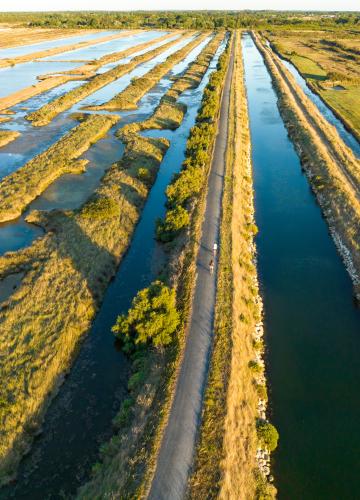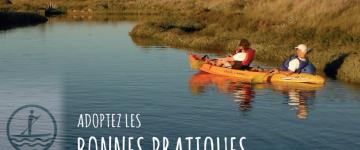
Marshes
The île d'Oléron and the bassin de Marennes possess some of the most significant areas of wetland in France. Marshland covers 40% of the île d'Oléron, 60% of the bassin de Marennes and over 70% in certain municipalities, notably Nieulle-sur-Seudre and Hiers-Brouage. Make the most of the cycle paths at your disposal and drink in the diversity of landscapes that is so characteristic of this habitat.
A fragile balance
Shaped over the course of centuries by mankind, for hundreds of years this marshland habitat produced the precious salt that was vital in food preservation. In the 18th century it was switched to the production and farming of oysters. Today, the marshes represent an important part of our heritage, but they are also a very fragile ecosystem. The wild, unspoilt character of this habitat makes it a haven for migratory birds such as waterbirds like various kinds of geese (including Barnacle geese) and small wading birds. It also provides nesting sites for some very rare European passerines.

Nowadays, most of the marshes on the île d'Oléron and the bassin de Marennes (especially in the environs of Brouage), are Natura 2000 protected areas. This natural heritage is a major part of the identity of the region and one of the things for which the area is known. It’s also a key element of many tourist-related and traditional occupations (wine-making, fishing, shellfish farming, salt production etc.) and represents a kind of life insurance policy for the local inhabitants. In fact, marshes have a natural water retention function, helping reduce the risk of flooding. Any damage to these natural habitats is not only a threat to the region’s cultural identity but also to the long-term economic prosperity of the local area and the quality of life on the île d'Oléron and the bassin de Marennes. This is why protecting this natural heritage is so important.
Providing a home for both fauna and flora
Half-land, half-water, the marshland is only a few centimetres above sea level. It can just about be glimpsed by walkers and recreational boaters. To explore its riches, stroll down its narrow paths and wander between its oyster beds. This will give you a real idea of the sheer complexity and variety of this habitat in terms of both animal- and plant-life.
The rich variety of the fauna and flora of the Marennes Oléron region
Amongst other marshes, why not visit the marais des Bris, a 37 hectare nature reserve reclaimed from the sea in the 19th century. It is now owned by the Conseil Général de la Charente-Maritime. Boasting much precious wildlife such as birds and orchids, it’s possible to visit the reserve with or without an expert naturalist. A footpath, fitness trails and games for children will make for a fun and educational family day out.
Did you know that around 250 species of birds and over 30 species of mammals have been recorded to date? As to plant-life, there’s plenty of it! Almost 140 species have been found here. Most of these species are found in the dunes and the wetland areas.
In the bassin de Marennes, let’s turn the spotlight on the marais de Brouage marsh, an important habitat for many species, enabling them to maintain their numbers or even expand their populations. More than 150 species breed here such as grey herons, purple herons and egrets. Since 1978, white storks have nested here, in what is a key site for the species in the region, thanks largely to the local birdwatching group in Brouage and plentiful food supplies.

Les marais de la Seudre, de Brouage et de l'île d'Oléron sont des espaces naturels façonnés depuis des siècles par des activités humaines. Ils sont reconnus pour leur exceptionnelle diversité. Envie d'une découverte des marais en kayak ou en paddle ? Découvrez les bonnes pratiques à adopter lors de vos balades en kayak, canoë ou paddle dans nos marais !